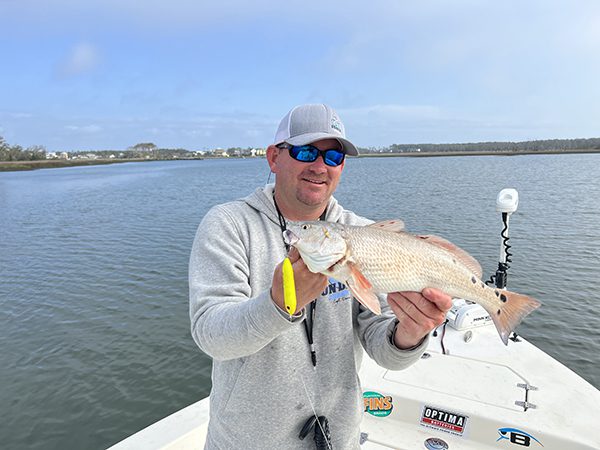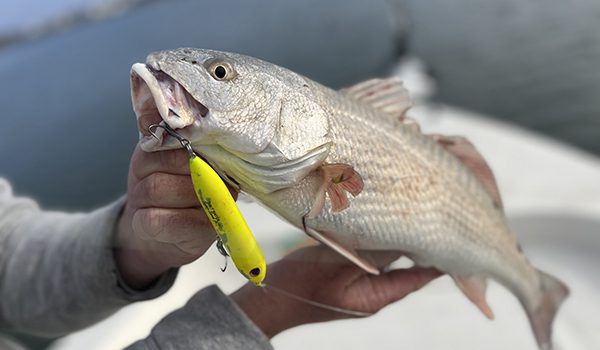Tidelines – April 2023
With windy day after windy day and unpredictable weather shifts, the ability to put together a March fishing trip for a Tidelines article can be daunting, and it was those challenging conditions that cancelled several plans and led to my Hail Mary phone call to Capt. Daniel Griffee, of On Deck Fishing Charters out of the Morehead City area.
I told Daniel I had just written about a trout trip, everything nearshore was going to be blown out, and I wanted to write about early season red drum fishing. We were coming off of a cold snap, winds were forecasted to be blowing over 20 mph on Saturday with a front moving through but more like 10-15 mph on Sunday, and even though we weren’t sure how quick or how slow that Saturday evening front would be pushing through, Daniel graciously agreed to give red drum a try under my added pressure of “needing just one good fish to write about but really really needing that one good fish.”
I asked him the game plan as we pulled away from the Radio Island public boat ramp.
“Basically, this time of year you go out and you put the trolling motor down,” Daniel explained, “and if you have the conditions that are conducive, you want to sight fish where you’re actually looking for the fish before you cast on them. And if it’s not conducive, then you go and blind cast to areas where you have seen them.”
Daniel had been on reds throughout the winter, but in March these reds start to break out of the schools of 25-100 fish and move around in pods of 4 fish or 10 fish or 20 fish.
“While summer blind casting can be very productive,” he continued, “late March blind casting can be problematic because you have no real bait around and your fish aren’t ‘home’ anywhere. They’re just meandering around looking for bait or meandering around because there isn’t any bait.”
Our early morning conditions were only somewhat favorable. Though we had an overcast sky, fortunately the wind was much less than forecasted and the tide was just starting to come in. Our first spot was an area where he had been seeing fish, and the low water would hopefully have the fish in predictable locations.
“There’s a mullet, and there’s the push. Do you see them?” he asked as the trolling motor brought us around a bend to an area of scattered oyster rocks in about one foot of water and nestled between a dock and a grass line.
“A mullet push and a drum push are two totally different pushes. A mullet push is like if you threw a rock in the water and got a little ripple off of it. A red drum push is more like a boat wake, or at least a remote-control boat wake. A mullet will swim in circles. A drum’s wake will be going a certain direction.”
Our fish were pushing from left to right and a little away, and, luckily, they weren’t spooked. They were just casually moving in the waters up ahead.
I had a soft plastic, a 3” chartreuse Z-Man paddle tail on a 1/4 oz. jig head. Daniel likes the paddle tail for its steady retrieve and bounce along the bottom, and he likes the 1/4 oz. not for its fall ratio but because it gives enough weight for a long cast.
“Guess where you think they are heading, and throw it in front of them so they run into your bait,” was my in-the-moment briefing from Daniel. “Whereas, if you throw it on top of them, you have a real chance to spook them and they may go in all different directions. You also don’t want to lead them too far because the odds are greater they may turn off of your bait.”
We threw the paddle tail, we threw topwater, and Daniel even threw a modified dropshot rig that is popular with smallmouth bass fishermen—about 6” down from his uni-to-uni knot connecting braid to the leader line, he ties on a Gulp bait, and then 8” or so down from the Gulp bait (the length varies depending on the depth of the water) he ties a swivel with a weight on it.
“The idea is when those fish are in a school moving, you can throw the dropshot rig in front of them, keep tension on it, and that keeps the bait not laying on the bottom but in sight above the rocks where they are swimming,” he explained.
Three different baits and several casts later, we didn’t have a bite. We left them to calm down, with the plan to come back, and moved on to the other side of the dock where we immediately identified another pod of reds pushing water.

Capt. Daniel Griffee, of On Deck Fishing Charters, with a slot red drum that fell for a topwater. He was targeting some oyster rocks off a grass line in the Morehead City area.
This pod, though, was spooky, and they booked it before we could get a cast in front or even on top of them. Daniel started a drift in the direction down the grass bank where they disappeared, and he sent a topwater flying as far as he could to some barely covered rocks extending from a point. We had lost the pod so it was a blind cast, but that’s the purpose of the topwater—to cover more water quickly to either get a hookup or get the fish to show themselves again.
Bringing the topwater back across that point, we got our hookup. A slot red committed and smacked the chartreuse Super Spook Jr.
Daniel was relieved to meet the pressure of the trip—one good early spring red drum to write about—and I immediately changed the rules and asked for more. Of course we kept fishing.
If you like red drum fishing even half as much as Capt. Daniel Griffee of On Deck Fishing Charters out of the Morehead City area, then get on his boat and let him show you the excitement of the hunt and (hopefully) reds pushing water or reds swimming in the water. Sight casting for reds would be a great reward for yourself for making it through another cold winter season.
The redfishing starts to really heat up by the end of April and into May, and then June is his favorite month. You can find out more information, including available trips, as he also likes the springtime for such species as gray trout, bonito, and spanish, at www.ondeckfishingcharters.com.
Tell him all you need to be happy is to sight cast to one good redfish, and then as soon as you catch that one good redfish, smile and tell him you now want more.






